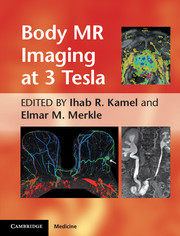Book contents
- Frontmatter
- Contents
- Contributors
- Foreword
- Preface
- Chapter 1 Body MR imaging at 3T: basic considerations about artifacts and safety
- Chapter 2 Novel acquisition techniques that are facilitated by 3T
- Chapter 3 Breast MR imaging
- Chapter 4 Cardiac MR imaging
- Chapter 5 Abdominal and pelvic MR angiography
- Chapter 6 Liver MR imaging at 3T: challenges and opportunities
- Chapter 7 MR imaging of the pancreas
- Chapter 8 MR imaging of the adrenal glands
- Chapter 9 Magnetic resonance cholangiopancreatography
- Chapter 10 MR imaging of small and large bowel
- Chapter 11 MR imaging of the rectum, 3T vs. 1.5T
- Chapter 12 Imaging of the kidneys and MR urography at 3T
- Chapter 13 MR imaging and MR-guided biopsy of the prostate at 3T
- Chapter 14 Female pelvic imaging at 3T
- Index
- Plate section
- References
Chapter 11 - MR imaging of the rectum, 3T vs. 1.5T
Published online by Cambridge University Press: 05 August 2011
- Frontmatter
- Contents
- Contributors
- Foreword
- Preface
- Chapter 1 Body MR imaging at 3T: basic considerations about artifacts and safety
- Chapter 2 Novel acquisition techniques that are facilitated by 3T
- Chapter 3 Breast MR imaging
- Chapter 4 Cardiac MR imaging
- Chapter 5 Abdominal and pelvic MR angiography
- Chapter 6 Liver MR imaging at 3T: challenges and opportunities
- Chapter 7 MR imaging of the pancreas
- Chapter 8 MR imaging of the adrenal glands
- Chapter 9 Magnetic resonance cholangiopancreatography
- Chapter 10 MR imaging of small and large bowel
- Chapter 11 MR imaging of the rectum, 3T vs. 1.5T
- Chapter 12 Imaging of the kidneys and MR urography at 3T
- Chapter 13 MR imaging and MR-guided biopsy of the prostate at 3T
- Chapter 14 Female pelvic imaging at 3T
- Index
- Plate section
- References
Summary
Background
Colorectal cancer is the third most common cancer in men and the second most common cancer in women, with an age-adjusted incidence rate of 46.1 per 100 000 per year in the United Kingdom [1]. The estimated number of deaths in the United States in 2009 was 49 920 [2]. Therefore, colorectal cancer has a high impact on health and society. Until now the precise etiology of rectal cancer has not been clarified. It is currently believed that the etiology is multifactorial, with genetic factors on the one hand and environmental factors, such as diet, smoking, and exercise, on the other hand. Patients usually present with rectal bleeding, weight loss, or abdominal complaints. Based on these symptoms a colonoscopy with biopsy is performed, where a tumor is found. Patients then undergo local staging with MR imaging, which has been proven to be the most accurate modality for staging of rectal cancer [3]. Distant staging is performed with computed tomography (CT) of the abdomen and thorax or a combination of a chest X-ray and an ultrasound of the liver. After staging, the patient is discussed in a multidisciplinary team (MDT) meeting, where the risk profile for recurrence is evaluated. A colorectal MDT consists of surgeons, radiation oncologists, medical oncologists, pathologists, gastroenterologists, and radiologists. Over the years, the role of the radiologist in the MDT has evolved from a reporting role to a full sparring partner in clinical decision-making. Because the aim of imaging of rectal cancer is to determine the risk profile of the patient, which defines the type of treatment the patient will undergo, the radiologist nowadays has a crucial influence on the treatment of the patient.
- Type
- Chapter
- Information
- Body MR Imaging at 3 Tesla , pp. 150 - 163Publisher: Cambridge University PressPrint publication year: 2011



